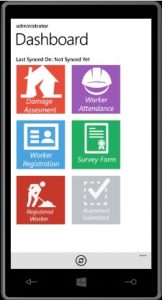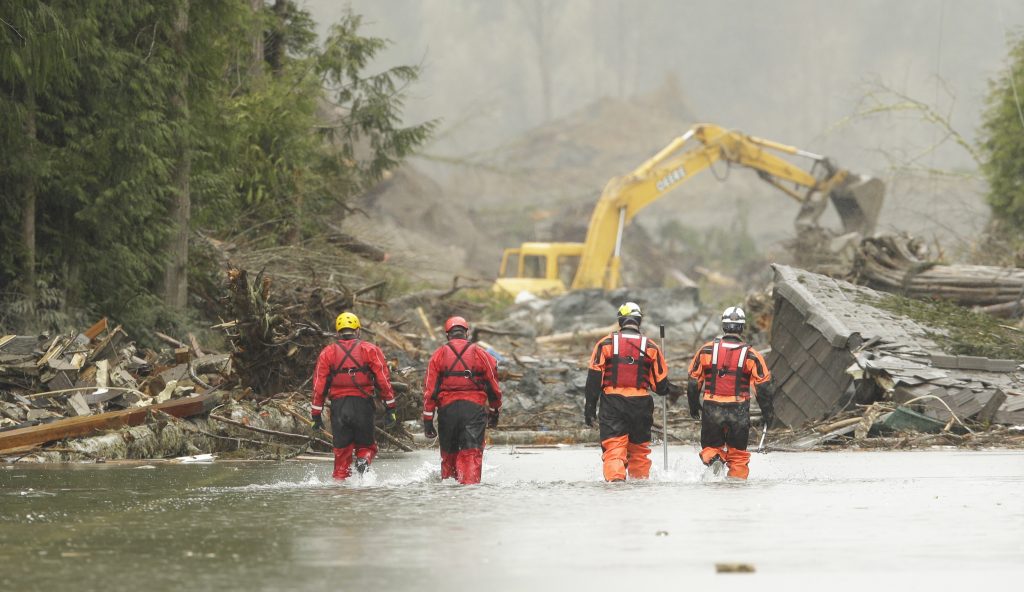Things to Come: When disaster strikes, technology comes to the aid of communities in crisis
When a disaster occurs, you’ve entered a “new reality,” says Lewis Curtis, director of Microsoft Services Disaster Response. It won’t be enough to simply restore your systems and applications to where they were before – disasters change everything, irrevocably and permanently.
But new computing technologies like the cloud are making it possible to quickly respond to a disaster, coordinate the response by governments and aid organizations, provide analytics to better understand and track its impact, and manage the aftermath. All of the same technologies and innovations that enable businesses to quickly respond to new opportunities and changing market conditions make the cloud an essential part of any disaster response.
Using technology to ease suffering
Disasters often wipe out the very systems that are desperately needed to cope with them.
Michael G. Manning, president and CEO of the Greater Baton Rouge Food Bank in Louisiana, understands this well. In August 2016, Baton Rouge, the state’s capital, was inundated by record rains. Four feet of flood water destroyed not only a million pounds of food held in reserve, but all of the food bank’s computer systems, the very ones that tracked the food bank’s supplies and who received them, and that ensured that hungry people were getting the food they needed.
Quickly moving their office and warehouse management applications to the cloud guaranteed that those applications would always be available, and that the loss of their systems “would never happen again,” Manning says. With cloud-based applications, the food bank could “operate anywhere, at any time, in any future disaster.”
Only months before, a magnitude 7.8 earthquake ravaged western Ecuador, and the government needed a basic software application to register those affected by the quake, and to ensure that shelter, food and medical supplies reached the 2,300 families left homeless by the disaster.
Neighboring Colombia had such an application. But how to quickly move it to Ecuador and get it running? In fact, within a week it was redeployed – to the Azure cloud. The Ecuadorian Red Cross also used the cloud to manage volunteers and blood bank data across the country.
In other cases, disasters bring new demands on applications – in both scale and load – that were never anticipated.
On March 22, 2014, a hillside saturated by heavy rains collapsed on the small Northwest town of Oso, Washington, flattening homes and killing 43 people. In the aftermath, nearly 200 government and aid agencies, including the Red Cross, the Federal Emergency Management Agency, the Washington National Guard and the U.S. Navy’s search and rescue team, as well as thousands of representatives of the media, descended upon Oso.
The local government’s record-keeping and coordination systems were quickly overwhelmed so Microsoft Services Disaster Response, with help from the Azure product team, migrated Oso’s records to the cloud. With its nearly limitless capacity, the cloud made it possible for everyone who needed access to the records to retrieve – and search – them quickly and efficiently. Using Office 365 they also quickly deployed an Incident Command Collaboration System that enabled incident commanders and emergency liaisons from the various agencies to connect with one another.
A year later, a massive earthquake leveled some 600,000 buildings and killed thousands of people in Nepal, leaving the remote, mountainous country faced with the massive task of rebuilding. “Disaster relief is always overwhelming,” Dan Strode, project manager for the United Nations Development Program (UNDP), said at the time. “There’s too much to do, too many people that need help, and never enough time or resources.”

The daunting task of rebuilding began with mapping where the original structures had stood. In the past, such records were maintained on paper. However, in order to expedite reconstruction, the Microsoft Innovation Center in Nepal built a mobile phone application that used a device’s GPS to help workers record the outline of a damaged home and store it in the cloud before clearing the debris. And to help restart the economy, the app also managed daily cash payments to the workers. Cloud applications like Office 365 and the data visualization tool Power BI helped them to coordinate and track progress.
Using artificial intelligence and the cloud to provide early warning
We can use modern technologies to respond to disasters, but could we someday use them to predict, or even prevent, these natural catastrophes?
Perhaps! A statistical algorithm known as M8 attempts to predict larger earthquakes from the appearance of smaller ones. A number of efforts in different regions around the world are applying neural networks (an artificial intelligence approach that simulates the activity of the human brain) in attempts to predict the occurrence and the magnitude. (Here’s an example from Chile; and one from India.)
In Texas, Project “SHEM” (streamflow hydrology estimate using machine learning) uses artificial intelligence to predict floods even when the physical gauges that measure water levels fail; a computer model is “trained” using historical data to look for patterns that signify the water is rising.
And the cloud may well give new hope to solving the age-old problem of predicting the weather. One prototype application (written, by the way, by your own intrepid author) uses several hundred processors in the cloud to load and analyze a century’s worth of weather data from reporting stations around the world. The hope is that the capacious data set can be analyzed to identify long-term trends and answer some of our most troubling “what ifs” about weather events.
Rely on the cloud for scale, resilience and rapid response
Aside from the wonderful humanitarian nature of these stories, what is it that is so compelling and relevant about using technology for disaster recovery?
What aid agencies and governments are finding so useful about the cloud, machine learning and other emerging technologies – resilience, time to market, scale, agility – are all qualities that are essential in today’s rapidly changing business world.
Need to get the word out? You might take a page from the government of Alberta, Canada. To keep its citizens informed during the great wildfires of 2016, the government partnered with Microsoft and geographical information systems (GIS) partner ESRI to create a cloud-based mapping application of the fires.
Need new capabilities but don’t want to add IT overhead? The same lessons learned by the governments in Baton Rouge and Nepal can be applied to public and private companies. A sudden imperative to scale? Use the cloud, as they did for the Oso landslide.
New technologies are often proven in the crucible of disasters, and they drive new innovations that promise to keep us safer, long after the crisis has ended.
A 40-year veteran of the software industry, Barry Briggs previously served as CTO for Microsoft’s own IT organization, where he helped lead the company’s transition to the cloud. The Microsoft Services Disaster Response team in the last few years has operated more than 154 missions in over 30 countries, at no cost to the agencies or communities who ask for help.
Top photo: Search and rescue teams continue to work on March 27, 2014 in Oso, Washington. (Photo by Ted S. Warren-Pool/Getty Images)








